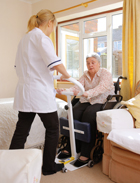
The growing disparity between the average American’s weight and safe lifting requirements presents a challenge for long-term care workers who perform heavy lifting. As a result, facilities with safe resident handling training programs have significantly lower rates of caregiver injuries than facilities without such programs, new research finds.
Investigators from Prevent Inc., a safe handling development service, monitored 105 long-term care facilities for 12 months before and after the implementation of a safe resident handling program. In the year before the program started, the combined facilities reported 682 caregiver injuries related to resident lifting and transferring, for a total cost to the facility of $3.5 million. In the year after the program started, only 45 injuries were reported, resulting in a total cost of about $110,000.
The researchers noted that while training caregivers to use mechanical lifts can be helpful, inadequate training can be hazardous. The average weight of an American has creeped up to 175 pounds. Add a growing number of bariatric patients, and the result is high transfer and mobilization demands.
“The best practice is to use expert-level safe handling nurses who train, mentor and observe the caregiver’s skills during the provision of care,” they wrote.
Prevent investigators also surveyed 10,000 caregivers who had worked in long-term care facilities with and without safe handling programs. The majority said they would always choose to work in a facility with such a program in place if given the option.
Prevent researchers noted that caregivers who demonstrate competency with lifts and other equipment were also more likely to be compliant with safe resident handling. Furthermore, the study authors recommended that nursing homes should audit caregivers’ safe handling skills routinely. They noted that assessing and documenting caregiver competence with equipment also gives residents a chance to voice any concerns they might have about their transfers.
The study was published in the July issue of the Annals of Long-Term Care.
From the September 01, 2011 Issue of McKnight's Long-Term Care News





